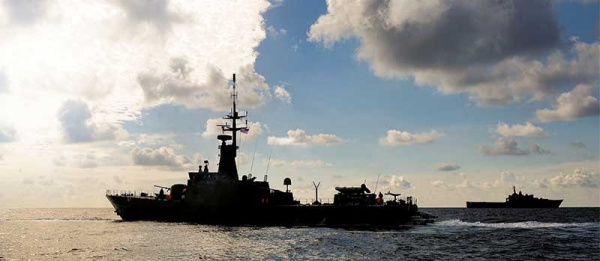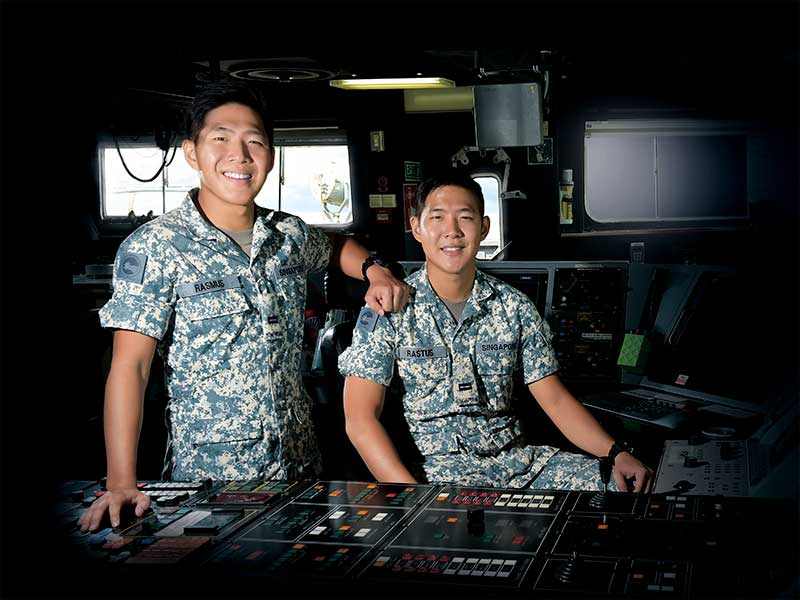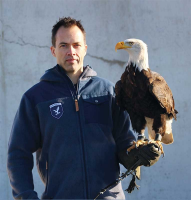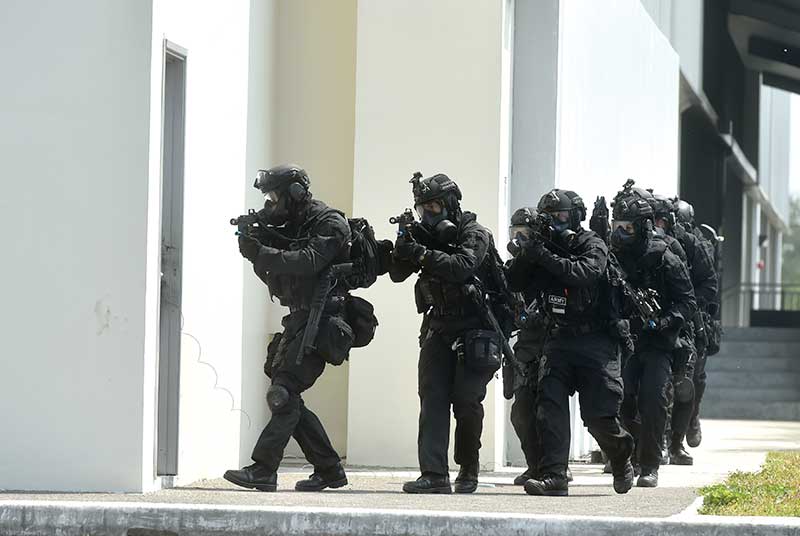Whether you are getting ready for the office or tucking your children into bed, the RSN is keeping vigilant watch over our seas, giving us the peace of mind to work and play in the day and sleep tight at night.
As a member of the global maritime community, the RSN contributes to international maritime security efforts outside of our waters. This includes Operation Blue Sapphire, the SAF's contribution to multinational counter-piracy efforts in the Gulf of Aden.
Closer to home, the RSN also plays an active role in protecting our surrounding waters from pirates and sea robbers. Together with our neighbours Indonesia, Malaysia and Thailand, Singapore set up the Malacca Straits Patrol (MSP).
This is a set of cooperative measures to carry out coordinated patrolling and information-sharing to keep the Straits of Malacca and Singapore safe for the numerous vessels that ply through every year.
The MSP comprises three components: the Malacca Straits Sea Patrol (MSSP), the "Eyes-in-the-Sky" (EiS) air patrol and the Intelligence Exchange Group (IEG). In addition, the RSN's Information Fusion Centre (IFC) maintains the MSP Information System (MSP-IS), an information-sharing portal that also allows users to chat and exchange data.
Close coordination
Keeping pirates at bay
Like policemen patrolling a neighbourhood, the MSSP allows the nations to show their presence in the Straits of Malacca and Singapore, thereby discouraging sea robbers from attacking commercial vessels.
At times, the naval ships may be required to accost the pirates or sea robbers and disrupt their illegal activities. They may also escort the victim vessels to coast guards, who would then carry out investigations and arrests.
For the RSN's Fearless-class Patrol Vessels (PVs), which will soon be replaced by the Littoral Mission Vessel, this is an extension of their primary role in defending the Singapore Strait and our territorial waters.
"Our key responsibility is to safeguard our sovereignty, and also protect Singapore against maritime terrorist threats. Every day, a PV patrols the Singapore Strait to show our presence and conduct escort duties to ensure the safety of the international shipping community that is calling at or passing by Singapore," said MAJ Ray Ong, a Staff Officer in the Operations Planning Branch of the Maritime Security Task Force (MSTF). He was previously the Commanding Officer (CO) of PV RSS Resilience.
"Under the MSP initiative, we commit our forces to show our presence in the Straits to deter pirates and sea robbers," he added.
Captain (CPT) Tan Jin Chuan, RSS Resilience's Navigation Officer, agreed: "Our presence plays a part in deterrence. If we are around, the small boats wouldn't dare to do anything since it's a government vessel with weapons on board.
Strong HQ-to-HQ ties
Once discovered, pirates and sea robbers often take advantage of the crowded waters and sea borders to escape their pursuers. But through close sharing of updates and new information, all the countries can help to track the fleeing pirates and apprehend them swiftly.
For Singapore, the MSTF acts as the MAA. With active links to information-sharing platforms, operations groups within the SAF and border security agencies, the MSTF has oversight of the larger maritime picture and can better deploy assets to investigate incidents at sea.
The importance of this collaboration came to the fore recently when the RSN, Indonesian Navy (IDN), Royal Malaysian Navy (RMN) and Malaysian Maritime Enforcement Agency (MMEA) disrupted a robbery attempt on Malaysian-flagged tugboat Permata 1 (see "Rescuing Permata 1").
After the RSN's RSS Resilience accosted the robbers -- who were aboard a sampan (small wooden boat) -- they fled south towards Indonesian waters. While escorting Permata 1 to safety, the PV reported its progress to the MSTF headquarters. Through the IFC, the IDN received the update and picked up on the sampan's trail, eventually capturing the sea robbers.
"The success of the Permata 1 incident is a good testament of the cross-national agencies working together," MAJ Ong said of the successful disruption. As the CO of the PV then, he was responsible for maintaining communications with MSTF and overseeing the mission.
"The close HQ-to-HQ linkages allowed information to flow seamlessly so that the agencies could respond to the incidents in a timely manner and apprehend the pirates."
Rescuing Permata 1
On 1 Sep 2015, RSS Resilience was informed by MSTF HQ that Permata 1, a tugboat towing a barge loaded with scrap metal, was in distress. While travelling to the vessel's last-known location, the crew began preparing for a possible disruption by activating the gunners and Firefighting and Damage Control team.
Military Expert (ME) 1 Reshi Shankar, a Weapons Specialist Operator, was one of the gunners who had to stand ready at the CIS 50 machine gun. He recalled the incident: "We were at the guns, awaiting command. We then heard through the communications that this was not an exercise but a real situation."
Within 15 minutes, the PV located Permata 1 and identified the sampan that was harassing it. The ship then commenced with disruption manoeuvres, which included using loudhailers to warn the robbers off.
After the sea robbers fled, the PV escorted the tugboat to Singapore to facilitate investigations by the Police Coast Guard. The IFC contacted the IDN, RMN and MMEA to share updates from the PV, and the sea robbers were eventually apprehended in Indonesia.
MAJ Ong thanked his crew for a job well done: "Their fast response and great teamwork were contributing factors to the success of this mission."
ME1 Reshi was also glad to have disrupted the robbery: "Since we (as gunners) are at the front line, the lives of the crew are in our hands. I'm proud of my team."
Eagle-eyed
If the MSSP are the feet on the ground, then the EiS is, as its name implies, the all-seeing eye from up in the skies.
The air component of the MSP, which is undertaken by the Fokker 50 (F-50) Maritime Patrol Aircraft of the Republic of Singapore Air Force's (RSAF's) 121 Squadron (SQN), complements the PVs by providing a quick overview of the situation at sea.
CPT Pan Huishan, a Tactical Coordination Officer (TACCO), explained the difference between air and sea platforms: "Ships move slower and have more time for sense-making; on the other hand, aircraft fly at faster speeds and info comes in quicker. However, ships also have a longer endurance.
"So we'll do the initial tracking and if the situation requires closer monitoring or follow-up action, the MAA will deploy a suitable asset to investigate."
All eyes on deck
Since the EiS was launched in 2005, the RSAF has flown close to 700 sorties in support of the MSP. Patrols are conducted monthly, with 28 sorties shared among the four nations. Each sortie flown by the RSAF lasts two-and-a-half hours and takes the crew along the Singapore Strait up to the Strait of Malacca.
Before each sortie, crew members attend a briefing on matters such as the region's history of piracy-related activities and the rules of engagement. "It's important for the crew to fully understand the mandate and objectives of the mission," said MAJ Chew Keng Siang, an F-50 pilot and Officer Commanding in 121 SQN. He has been involved in EiS patrols for the last four years.
During the flight, the crew keeps a lookout from their various posts for suspicious activities on the Straits. For maritime patrolling purposes, the F-50 flies low, staying below 5,000 feet. It will also slow down or descend further if needed to allow the crew to investigate suspicious activities.
As Loadmaster, Master Sergeant (MSG) James Toh must be light on his feet. Armed with a pair of binoculars, he moves around the aircraft constantly and keeps a keen eye out the windows for movements on the surface.
Said MSG Toh: "I have to watch for small and fast-moving boats approaching merchant ships, and take photos of the suspicious contacts for ground reporting."
CPT Pan and other sensor operators, on the other hand, analyse radar readings to paint an accurate surface picture. Unlike her Air Force colleagues, TACCOs like her are naval officers by vocation.
"I wanted to learn how the Air Force and Navy work hand-in-hand to support naval missions," said CPT Pan of her decision to become a TACCO. She served on various naval platforms -- including the PV RSS Dauntless -- for about five years before joining 121 SQN in 2014. She began participating in EiS missions this year.
Her experience on Navy ships has proven valuable in her current role: "As specialised officers, we are trained in reading radars and compiling pictures of surface contacts. As on a ship, we take note of matters such as adverse weather or incoming aircraft that can compromise our mission and safety and advise the pilot appropriately."
MAJ Chew agreed: "The TACCOs are important to us because they know the processes on the Navy side of the house."
Friendly eyes
In every EiS sortie, the crew is joined by representatives from the MSP countries, who fly with them as the Combined Maritime Patrol Team (CMPT). In addition to assisting with the monitoring, they act as liaison officers for their home nations, expediting the process of sharing information with the other countries.
MAJ Chew flew in the CMPT with Malaysia in 2015, where he had the opportunity to participate in briefings and work alongside his counterparts.
"Like us, they are very professional and committed to the EiS cause. In observing the way they work, I am able to bring the knowledge back and see how I can improve my squadron's work processes."
The presence of the CMPTs has also benefited the crew, as CPT Pan explained: "They have vast experience and varying vocations and seniority; interacting with them enables me to better understand their views on the EiS."
Marking the MSP's 10th Anniversary
On 21 Apr 2006, the MSP Joint Coordinating Committee Terms of Reference and Standard Operating Procedures (SOP) was signed. Member nations agreed to undertake coordinated efforts in order to reduce piracy in the Straits of Malacca and Singapore. Every year, the waterway sees some 90,000 merchant vessels passing through, transporting a third of the world's traded goods.
This year, the MSP marked its 10th anniversary. At the commemoration ceremony held at the Changi Command and Control Centre on 21 Apr, Singapore's Chief of Defence Force Major-General Perry Lim unveiled the new MSP logo. The commemorative ceremony also coincided with the fourth MSP Information Sharing Exercise, held from 19 to 21 Apr.
Ten years on, the MSP's efforts have borne fruit. Lloyd's Joint War Risk Committee, which listed the Strait of Malacca as a war-risk zone in 2005, removed it from the list after a year. The number of piracy and sea robbery incidents was also brought down to zero at the end of 2015.
Building images and relationships
Without proper mapping and navigation, patrollers would effectively be sailing and flying blind. And so, the final piece completing the MSP was put in place with the formation of the IEG in 2006.
The IEG supports sea and air patrols by providing analysis on current trends and identifying hotspots along the Straits.
Sitting in Singapore's IEG are Co-Chairperson Head Naval Intelligence Colonel Victor Huang, Co-Secretary MAJ Neo Shee Chin, and members from the Naval Intelligence Department (NID) and MSTF.
Lieutenant Colonel (LTC) Jackson Pang, Head MSTF Intelligence Operations and Planning Branch and IEG member, explained his role: "Part of the MSTF's role is to monitor the piracy and sea robbery situation in the area, so I'm able to support the IEG in reporting numbers, trend analysis and sense-making."
Communication and sharing
Central to the IEG's purpose is information sharing. Having a common view of the Straits' surface picture is important, not only between a country's sea and air patrollers, but also among all the MSP nations. Thus the IEG cooperates with the RSN's IFC to develop and maintain the MSP-IS.
The MSP-IS is an information-sharing portal that allows users from all the participating nations to access and view the traffic situation in the Straits of Malacca and Singapore. Members can also communicate via the online chatrooms and update the image to keep others abreast of developments.
"Perpetrators don't respect boundaries -- they may commit a crime in the waters of one country and escape into another's," said MAJ Xing Yongzhi, Head Operations and Exercise in the IFC.
"With information-sharing, there can be cooperation in the event of a pirate attack or sea robbery."
Meeting of international minds
The IFC also plays host to International Liaison Officers (ILOs) from the MSP countries. Like the CMPTs on board EiS flights, they help to relay information quickly between Singapore and their home countries.
Lieutenant Commander (LCDR) Muhammad Hafiz bin Othman, an ILO from the RMN, believes the MSP is important in keeping the Straits safe: "The MSP initiative is unique because it reflects the commitment and close cooperation among the littoral states.
"This kind of multilateral cooperation is essential in combating trans-border crime that can threaten the overall security of the Straits."
Royal Thai Navy ILO Commander (CDR) Komol Kongboonrak agreed: "Maritime threats that happen in one country can affect other countries as well. It is difficult for just one country to cope. So, multilateral cooperation is essential to counter these threats."
On 6 Apr, the Maritime and Port Authority of Singapore detected an attempted sea robbery by a sampan on a tugboat in Indonesian waters off Batam, and notified the Police Coast Guard and the MSTF.
The two agencies sprang into action. Through the Indonesia ILO at the IFC, the MSTF informed the IDN's Western Fleet Sea Security Group about the incident. This led to the arrest of the perpetrators the next day.
The ILOs also play another role -- that of planning and organising the MSP Information Sharing Exercises as members of the Exercise Planning and Control Team (EPCT). During the exercise, which takes place every 16 months, the various systems in the MSP are put to the test in simulated piracy or sea robbery incidents.
"It's a test of the linkages among the four countries, to ensure that everyone is communicating on the same platforms," said MAJ Neo.
The EPCT, which comprises the ILOs from each of the MSP nations as well as IFC Head Operations and Exercise, comb through case studies to devise exercise scenarios that would push the limits of both the command posts and assets.
"We want our scenarios to be realistic, so that they can challenge us," said MAJ Xing. As part of the EPCT, he was involved in planning this year's MSP Information Sharing Exercise, which ran from 19 to 21 Apr.
Fellow EPCT member LCDR Muhammad Hafiz agreed: "The approach is to sensitise and provide a platform to improve existing procedures. As the Exercise Controller, I hope the participants will benefit from it."
Trust and friendship
Like the MSSP and EiS, the co-chairpersons of each country's IEG meet at a JWG meeting, held every four months.
During the meetings, which the countries take turns to host, members consolidate their assessment and analysis, and update the shared surface picture of the Straits.
"The respective countries will come with their analysis and evaluation, and we compile the data, which includes trends, number of incidents and assessments," said MAJ Neo, also a Staff Officer of NID.
However, apart from simply exchanging information, the JWG meetings play an equally important role in fostering relationships between the
MSP countries.
LTC Pang explained: "Trust is a key component, and the intimacy of a face-to-face meet-up to discuss things help to build up our operational synergy."
MAJ Neo added: "It's about building friendships with our counterparts, so that when an incident occurs, assistance is only a phone call away."
MSP milestones
20 Jul 2004
MSSP is launched with original members Malaysia, Indonesia and Singapore.
13 Sep 2005
EiS is launched with Malaysia flying the inaugural sortie.
21 Apr 2006
MSP SOP is signed.
7 Aug 2006
IEG is launched.
28 Mar 2008
First MSP Information Sharing Exercise is conducted. Subsequent exercises are conducted every 16 months, alternating between Command Post Exercises and Field Training Exercises, which involve sea and air assets.
18 Sep 2008
Thailand joins MSP as the fourth member.







